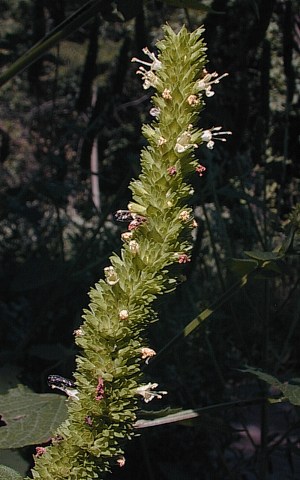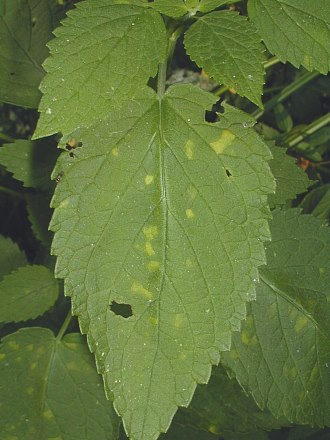 Description:
This herbaceous perennial plant is 4-7' tall and little branched,
except
for a few stems developing from the middle to upper leaf axils. The
central stem is light green, glabrous, 4-angled, and strongly winged.
The opposite leaves are up to 6" long and 3" across, while their
petioles are up to 2" long. The leaves are lanceolate-ovate or
cordate-ovate, medium to dark green, and hairless or nearly so; their
margins are coarsely serrated. At the apex of a plant, young vegetation
may be slightly pubescent. The central stem and major secondary stems
terminate in individual spikes of flowers. Each spike is about 4-16"
long and ¾–1" across; the length of each spike is highly variable
depending on the size of each plant and its maturity. The flowers are
densely crowded together all around the spike, although only a few
flowers are in bloom at the same time. Each flower consists of a
tubular corolla about 1/3" (8 mm.) long and a tubular calyx about 1/4"
(6 mm.) long.
The pale yellow corolla has 2 upper lobes, 2 lateral lobes, and a
single lower lobe that is the largest in size. These lobes are short
and rounded. The light green calyx has 5 teeth and several veins along
its sides; it is hairless or mostly hairless. Each flower has 4 stamens
that are strongly exerted from the corolla and a divided style. The
blooming period occurs from mid-summer to early fall and lasts 1-2
months. Individual flowers are short-lived. At maturity, each flower is
replaced by 4 nutlets. The root system is fibrous and rhizomatous.
Clonal colonies are often produced from the rhizomes.
Description:
This herbaceous perennial plant is 4-7' tall and little branched,
except
for a few stems developing from the middle to upper leaf axils. The
central stem is light green, glabrous, 4-angled, and strongly winged.
The opposite leaves are up to 6" long and 3" across, while their
petioles are up to 2" long. The leaves are lanceolate-ovate or
cordate-ovate, medium to dark green, and hairless or nearly so; their
margins are coarsely serrated. At the apex of a plant, young vegetation
may be slightly pubescent. The central stem and major secondary stems
terminate in individual spikes of flowers. Each spike is about 4-16"
long and ¾–1" across; the length of each spike is highly variable
depending on the size of each plant and its maturity. The flowers are
densely crowded together all around the spike, although only a few
flowers are in bloom at the same time. Each flower consists of a
tubular corolla about 1/3" (8 mm.) long and a tubular calyx about 1/4"
(6 mm.) long.
The pale yellow corolla has 2 upper lobes, 2 lateral lobes, and a
single lower lobe that is the largest in size. These lobes are short
and rounded. The light green calyx has 5 teeth and several veins along
its sides; it is hairless or mostly hairless. Each flower has 4 stamens
that are strongly exerted from the corolla and a divided style. The
blooming period occurs from mid-summer to early fall and lasts 1-2
months. Individual flowers are short-lived. At maturity, each flower is
replaced by 4 nutlets. The root system is fibrous and rhizomatous.
Clonal colonies are often produced from the rhizomes.
Cultivation:
The preference is light shade to partial sun, moist to mesic
conditions, and a fertile loamy soil. This plant dislikes dry sunny
areas, which will cause the foliage to wilt during a summer drought.
Range & Habitat:
The native Yellow Giant Hyssop is occasional to locally common in most
areas of
Illinois, except in the NW and southern sections of the state, where it
is uncommon or absent (see Distribution
Map). Habitats include deciduous woodlands, woodland borders
and openings, thickets, meadows in wooded areas, and powerline
clearances in wooded areas. Occasional disturbance is beneficial if it
reduces, but does not eliminate, the shade from canopy trees and other
kinds of woody vegetation.
Faunal Associations:
The flowers are visited by bees (e.g., honeybees, bumblebees, &
Halictid bees), bee flies, and butterflies. These insects suck nectar,
although some of the bees may collect pollen. Syrphid flies also visit
the flowers to feed on pollen, but they are less effective at
cross-pollination. The dense foliage of Yellow Giant Hyssop attracts
its fair share of predatory insects, including parasitic wasps,
spiders, ladybird beetles, and others. White-Tailed Deer leave the
foliage alone because of its bitter taste.

Photographic
Location:
A powerline clearance at Busey Woods in Urbana, Illinois.
Comments:
The pale yellow flowers are not very showy because they seem small in
comparison to the rest of the plant and only a few flowers are in bloom
at the same time. Thus, the attractiveness of Yellow Giant Hyssop
consists primarily of its foliage. Other species in this genus that
occur in Illinois are Agastache scrophulariaefolia
(Blue Giant Hyssop) and Agastache foeniculum (Anise
Hyssop). Blue Giant Hyssop is about the same size as Yellow Giant
Hyssop and it has a similar appearance, except that the corolla of its
flowers are blue and its stems are pubescent. Anise Hyssop has a
shorter stature than the preceding species and its foliage has an anise
scent; it also has flowers with blue corollas.